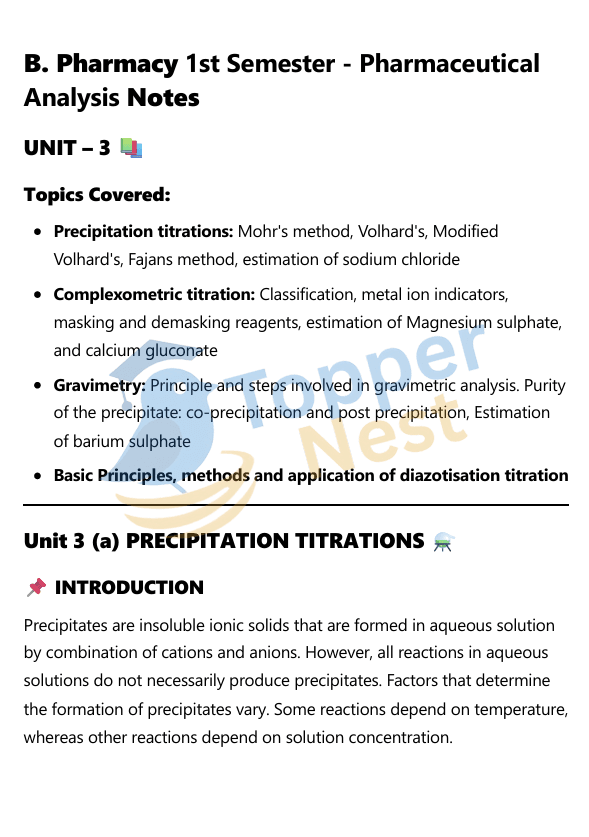In this unit, students learn about quantitative analysis methods that involve chemical reactions such as precipitation, complex formation, and gravimetric deposition. These methods are vital in the assay of pharmaceuticals, purity analysis, and metal content estimation. Each technique offers high accuracy and specificity, making them important tools in both academic and industrial pharmaceutical analysis.

What is Precipitation Titrations?
Precipitation Titrations are a type of volumetric analysis where the reaction between the titrant (solution of known concentration) and the analyte (solution of unknown concentration) results in the formation of an insoluble precipitate. The titration continues until all the analyte has reacted, and the equivalence point is usually detected by the appearance of excess titrant reacting with an indicator, or by the actual formation of the precipitate becoming visible.
Types of Precipitation Methods
- Mohr’s Method – Involves the use of silver nitrate and chromate indicator for the estimation of chloride ions.
- Volhard’s Method – A back titration method that uses thiocyanate and ferric ions in acidic medium.
- Modified Volhard’s Method – Similar to Volhard’s but performed under special conditions (like using nitrobenzene) to prevent precipitation of silver salts.
- Fajans Method – Uses adsorption indicators such as fluorescein to detect the endpoint of the silver ion titration.
Example Application: Estimation of Sodium Chloride using Mohr’s or Fajans method.
Definition of Complexometric Titrations
Complexometric Titrations, also known as Chelatometry, are a type of volumetric analysis based on the formation of a soluble, stable, and often colored complex between the analyte (typically a metal ion) and a complexing agent (ligand), which is the titrant.
Types of Complexometric Titrations:
- Direct Titration: The analyte (metal ion) is directly titrated with a standard EDTA solution. This is the most common and straightforward method.
- Back Titration: An excess, known amount of standard EDTA solution is added to the metal ion solution. The unreacted excess EDTA is then back-titrated with a standard solution of a second metal ion. This method is used if the metal ion reacts too slowly with EDTA, precipitates at the required pH, or doesn’t have a suitable direct indicator.
- Replacement/Substitution Titration: Used when the analyte metal ion does not form a sharp complex with the indicator or reacts slowly. The metal ion to be determined displaces another metal ion (e.g., Mg2+) from its EDTA complex. The displaced metal ion is then titrated with standard EDTA.
- Indirect Titration: Used for anions that don’t directly react with EDTA. The anion is first precipitated with a metal cation, and then the metal cation (either the amount consumed or the excess) is determined by complexometric titration.
Gravimetric Analysis
Gravimetric Analysis is a quantitative analytical method where the amount of an analyte (the substance being measured) is determined by precisely measuring its mass in a pure, stable form. It’s one of the oldest and most fundamental techniques in analytical chemistry, relying on accurate weight measurements.
Key Principle of Gravimetric Analysis:
The core principle of gravimetric analysis is to isolate the analyte in a highly pure and stable weighable form from a sample. Once isolated, the mass of this pure compound is determined. Knowing the chemical formula of the isolated compound and its stoichiometric relationship to the original analyte, the amount or concentration of the analyte in the original sample can be calculated.
Steps Involved in Gravimetric Analysis
- Precipitation of analyte
- Digestion (to form purer crystals)
- Filtration and washing
- Drying/Ignition
- Weighing the residue
Diazotisation Titration
Diazotisation titration is used for the estimation of aromatic primary amines by converting them into diazonium salts.
Basic Principles and Application
- Reaction between sodium nitrite and aromatic amines in an acidic medium.
- Endpoint detected using starch-iodide paper or potassium iodide solution.
Used For:
- Analyzing drugs like sulfanilamide.
- Testing purity of amine-containing drugs.
Frequently Asked Questions (FAQs)
1. What is the main use of precipitation titration in pharmacy?
It is mainly used for halide salt estimation like sodium chloride, which is common in pharmaceutical formulations.
2. Why is EDTA commonly used in complexometric titrations?
EDTA is a hexadentate ligand that forms stable 1:1 complexes with most metal ions, making it ideal for accurate metal estimation.
3. What is the role of masking agents in titration?
Masking agents bind selectively to interfering metal ions to prevent them from reacting with the titrant, ensuring specificity of the analysis.
4. What are common errors in gravimetric analysis?
Errors can occur due to co-precipitation, incomplete drying, or contamination of the final weighed product.
5. When is diazotisation titration used in pharmaceutical analysis?
It’s used for determining the amount and purity of aromatic primary amines found in drugs like sulfanilamide and others.
